Chance had a problem and a rough idea of the solution. Grasses were taking over his family’s vegetable garden, especially the pathways. Meanwhile, he was raising rabbits for meat. Rabbits eat grass but they also eat vegetable plants so he needed to build a pen that restricted them to the pathways.
We hopped on the Gator and drove over to the barn to look for scrap wood. Once upon a time, the barn held cattle through the winter, and straw still covers much of the ground, but these days the barn holds scrap wood and lots more. While pulling up pieces of wood to find the right ones for the rabbit pen project, we came across a dusty old periodical: “The Ladies’ Home Journal,” from 1896.
This property of about 670 acres in the Willamette Valley of Oregon was homesteaded, and the house that Chance, his wife Katie (my wife’s childhood friend), and their three children live in is the “new” house, built in 1900.

Chance and Katie own another house about a half hour away, but when they saw this place for rent a few years ago they decided to rent out their own house, which itself is on ten acres, and move over. Seeing the place, you understand why.
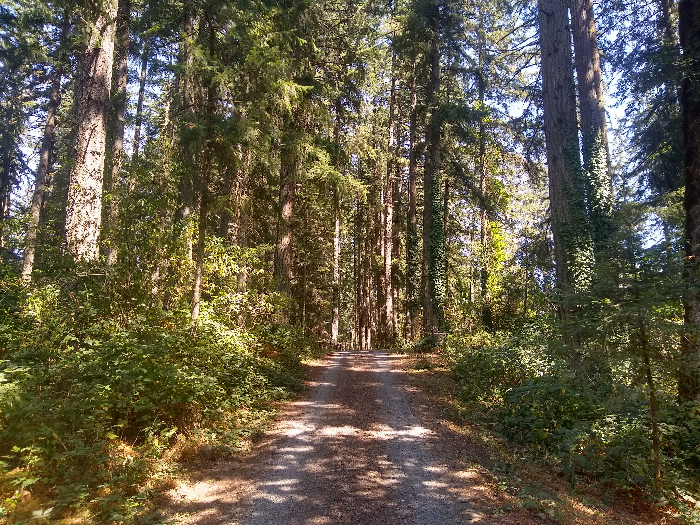
Much of the land is woods, and some of that is leased to a timber company. Some acreage is also leased to a cattle rancher. But all of it is accessible to Chance and Katie. One morning during our stay, we took a trail run of a few miles under Douglas Firs, around blackberries, and across oak savanna — never leaving their property.
White oaks surround the house, are draped with moss, and provided perfect summer shade for the kids to play under.
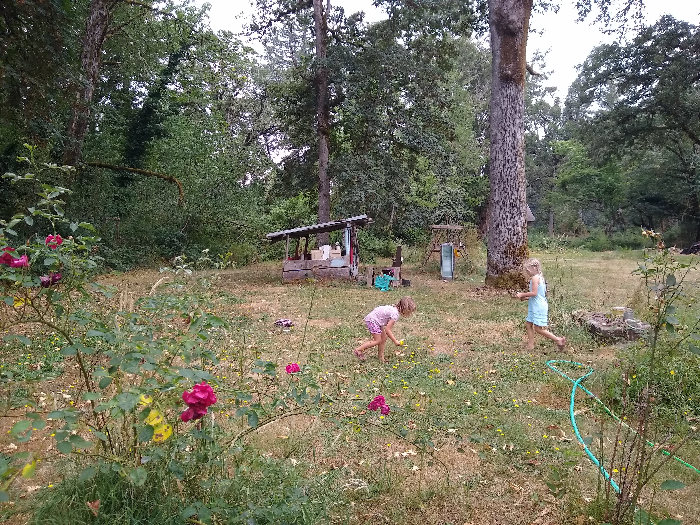
Because they have so much land to use, Katie and Chance keep many of their own animals too. We made carnitas tacos for dinner one night from the hogs they had raised last year. This year there are three goats. The goats take care of themselves, browsing for their own food. They also keep a few dozen chickens, that freely roam and peck, and that follow you around whenever you near them.
But how about getting those rabbits to feed themselves on grasses between the vegetables? We didn’t find the wood we needed in the barn, but we did find some in the scraps next to Chance’s bandsaw mill. Chance works as a surveyor of timber sales. He knows timber. On this property, the owner allows him to harvest and mill. Recently, all from trees on the property, he built an outdoor classroom for Katie, who is a school teacher and hosts nature lessons there. We hauled the scraps of wood back to the house in the Gator.
Chance cut the scraps to size. Then he had the idea of bending cherry boughs for hoops to form a roof. He led us to a cherry tree and we harvested the branches.
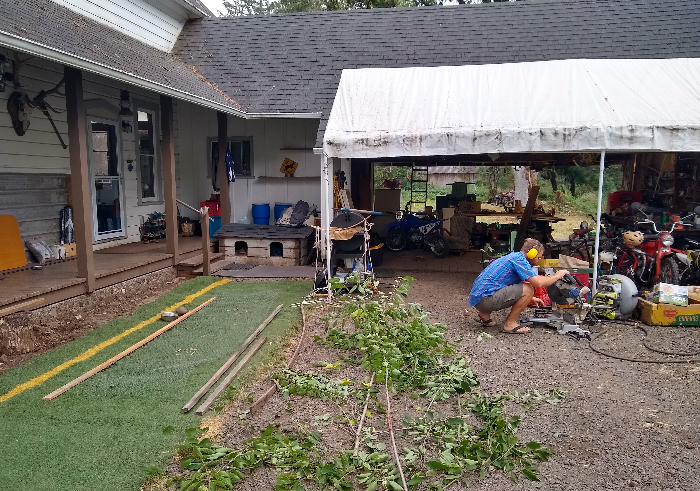
We fastened the scrap wood pieces into a rectangle for a base that was wide enough to fit between the vegetable rows.
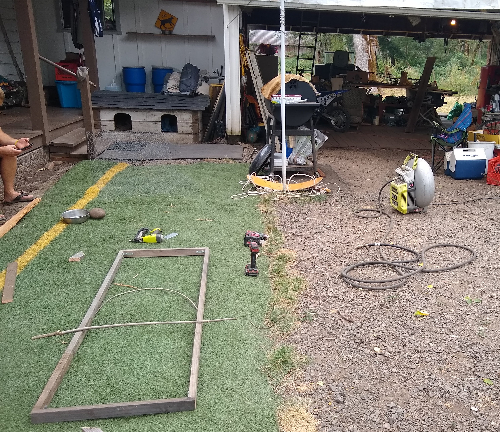
Then we began bending cherry boughs. Once we covered the boughs with poultry wire, we carried it to the garden.
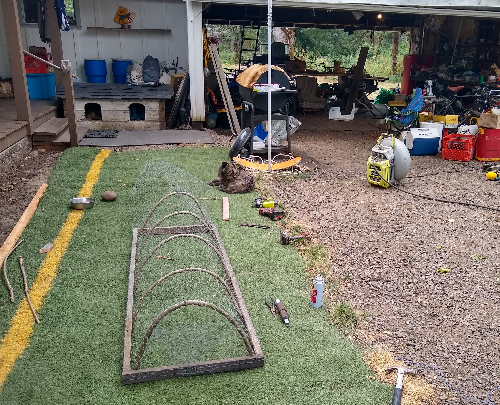
There the kids helped us put the rabbits into the pen.

How much grass would they eat by the time we got back from the creek?
We were there at the end of August during a heat wave so we headed over to the creek for a swim. We picked wild blackberries along the way, and wild plums and apples. A creek with a bedrock bottom meanders through their property and makes for an ideal summer cooldown spot and exploration site for the kids.

And they have dammed up a little swimming hole on the creek too.
Throughout our stay I had a recurring thought: This is everything you could hope for in a yard. It is what my yard would grow up to be.
Naturally, it’s got water, timber, shade, pasture, wild fruits and berries. Through Katie and Chance’s work it produces lots of food: abundant vegetables (primarily Katie’s domain) and meat from livestock (primarily Chance’s domain).
It is a complete yard. I couldn’t identify anything that it was lacking, and I felt rich just being surrounded by it all.
By the time we returned from swimming in the creek, the rabbits had eaten about half the grass in the pen, and they looked very satisfied.

It is beautiful when man collaborates with nature. Both are enhanced.
Thank you, Supporters, for keeping my Yard Posts coming, ad free. Here’s how you can support.
All of my Yard Posts are listed HERE

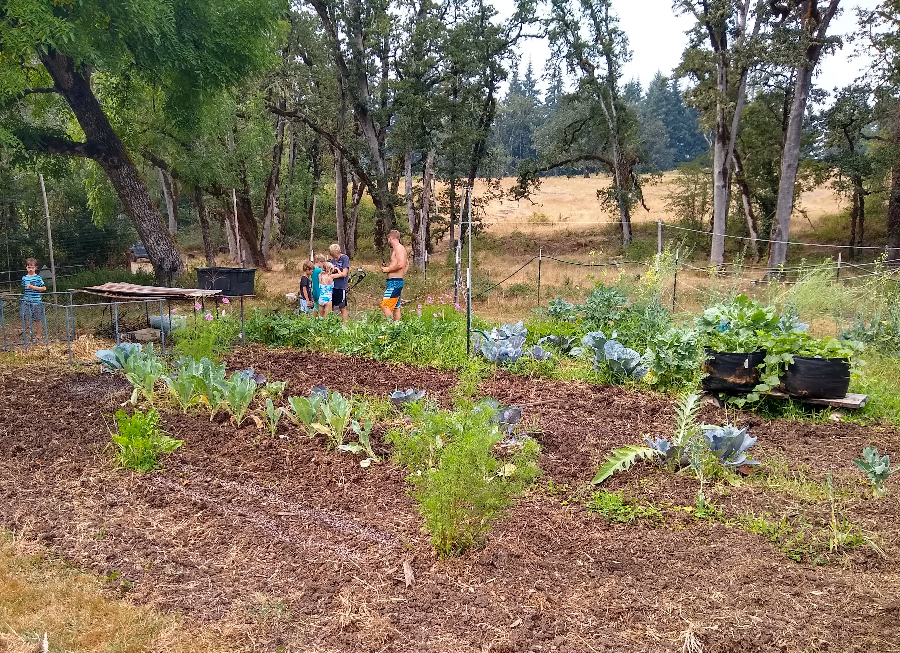


Good article. Wish I had a creek, but eh, got the ocean close by instead.
So far, my avocados have fared well in the heat. Several 110 degrees, two 111, and many at 102 to 106. I’m in Yorba Linda in the mouth of Santa Ana Canyon where desert air feeds into Orange County. My 10 year old Gwen is looking good, and the rest of my trees are about 2 years from planting. All get a small watering automatically each morning, just enough the soil never gets soggy. None of the trees have wilted. A few ‘cados on the Gwen had no leaf covering and got sunburn. I’m pleased.
It’s been a week to remember. I have covered a group of fuerte avocados that were laying on my garage roof with a large dog cot. Then I shaded two more groups with window screens I have saved. I had to water the tree canopy, bothered fuerte and Reed three times this week when temps reached over 100 degrees. This is in Santa Ana. Finally tropical storm Kay has arrived with rain and lower temps. Everything is good.
That’s a great property your friends have. Must’ve been a treat to visit.
This weather at the coast here- hot winds and 99 for several days. Got the drizzle today thankfully. My ettinger just dropped about 20 smaller avocados. And is now drooping on the eastern side which has the heavier crop load right now. All that dropped are around 2 » high. The larger 4 » ones are still on the tree. I’ve been spraying down the tree with a mist each day since.
My question is : must I toss these small fruits that have dropped?
On another note the lambs I bought from you took a while to ripen. Only one had a small black blot near the stem end. I just cut around it. The lamb are delicious and the thick skin took some getting use to!
Hi Kathryn,
It makes sense that the smallest avocados dropped. That’s what usually happens. The smaller (younger) the avocado, the more sensitive to heat and other stress.
You can just let those dropped fruit decompose under the tree if you want.
What a great way to live and enjoy life !
I was down on the Sea of Cortez fishing and missed the heat wave but had to put up with tropical storms from Hurricane Kay. Unfortunately my Avocados suffered. I’m in the Bay Area east of San Francisco. Strangely, my two seedling Avocados, with fruit, did not suffer at all nor did my Mexicola Grande,Zutano or Stewart, which is loaded with fruit. None of these trees showed any damage, no leaf scorch or fruit drop. My Hass, which had 14 fruit and beautiful new growth suffered with heavy leaf burn but no fruit drop. My Lamc and Sir Prize suffered new tip growth burn, even though they were shaded. Fuerte was shaded and was ok. Had I been home during this heat wave I probably could have reduced the damage, but all in all I’m grateful the damage was minimal. I’m waiting to see the outcome of the fruit on the trees that showed no leaf burn , but will it affect the fruit ?
Hi Tony,
Hope you caught some good fish down there. Most fruit drop and damage from heat shows up within a week or so. Some of it can trickle in later though. Check the stems of the fruit to see if they are browning or shriveling, which means the tree is preparing to drop them or at least stop feeding them.
Great article. It’s like I was there with you.